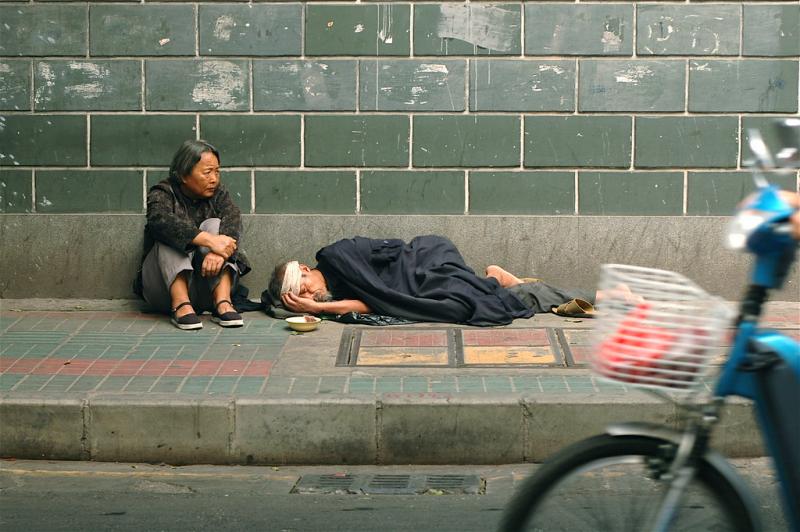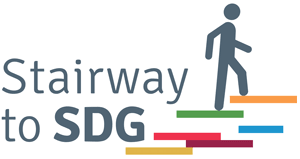Introduction

It's The Worrying That Kills You (By Tarotastic is licensed under CC BY 2.0).
Poverty entails more than the lack of income and productive resources to ensure sustainable livelihoods. Its manifestations include hunger and malnutrition, limited access to education and other basic services, social discrimination and exclusion, as well as the lack of participation in decision-making. In 2015, more than 736 million people lived below the international poverty line. Around 10 percent of the world population is living in extreme poverty and struggling to fulfil the most basic needs like health, education, and access to water and sanitation, to name a few. There are 122 women aged 25 to 34 living in poverty for every 100 men of the same age group, and more than 160 million children are at risk of continuing to live in extreme poverty by 2030.
The purpose of the proposed activity is to make the students understand through a role play that poverty is a concept in continuous evolution and that, even if we are part of more or less developed populations, there may be unforeseen events in our life path that could lead us to clash with the theme of poverty.
Poverty is infact a dynamic and complex concept which also involves areas such as education, livelihoods and access to health care.
The other part of the activity aims to motivate the students to make a change by helping people in need who they meet on the streets by providing them primary goods. The purpose is to increase the empathy of students for the issue of poverty by making them understand that through small daily gestures they can also be an active part of change.
Learning Objectives
- The learner knows about causes and impacts of poverty such as unequal distribution of resources and power, colonization, conflicts, disaster caused by natural hazard and other climate change-induced impacts, environmental degradation and technological disasters, and the lack of social protection systems and measures.
- The learner is able to show sensitivity to the issues of poverty as well as empathy and solidarity with poor people and those in vulnerable situations.
- The learner is able to identify their personal experiences and biases with respect to poverty.
- The learner is able to plan, implement, evaluate and replicate activities that contribute to poverty reduction.
- The learner is able to propose solutions to address systemic problems related to poverty.
- Systems thinking competency
- Anticipatory competency
- Collaboration competency
Instructions
Step 1) Introduction (45 minutes)
Students will watch a video: "Would you stop if you saw this little girl on the street? | UNICEF".
After watching the video the teacher will open a small debate with the students asking them how did watching the video make them feel:
- How does it feel to see this?
- Do you think this is an isolated event or something common in our society?
- Why do you think people react in one way or another to the same situation?
- What are stereotypes? Have you ever felt like a victim of stereotypes?
- What do you think are the causes of these thoughts?
- What are the causes of social and economic inequalities?
After the debate, the teacher will shortly introduce some facts about the first goal of sustainable development (the professors can draw inspiration from Websites to explain Sdg 1)
Step 2) Role-playing game (60 minutes)
The purpose of this activity is to make it clear that the concept of poverty is a dynamic concept that can affect any person at any time in his life.
Students will be divided into pairs and each pair will be given a card with the names of fictional people of different ages with different roles and jobs. (Documentes: Role-play. The dynamic of poverty)
The teacher will also say that he will gradually present certain situations and that consequently (Unforeseen) some people will have to change their behavior. The teacher should stress the importance of finding a solution despite the difficulties that have arisen. The aim of this activity is to highlight the work of ordinary people who may be poor. On the basis of this activity the teacher will help pupils to identify the interconnections between poverty, education, livelihoods and access to health care and understanding that poverty is a dynamic concept that evolves over time because of life’s contingencies.
Step 3) Distribute the budget (60 minutes)
Connecting with the role-play proposed above, where students have experienced firsthand poverty and vulnerability, we now explain to them how the public system through social services establishes social assistance. Social assistance is a tool to tackle inequalities. It makes it easier for the most vulnerable individuals, families and groups to meet their basic needs. The goal is to enable them to live in dignity. There are many types of aids for the unemployed, for young people, for disabilities...
The students are divided into groups (4 or 5 students) and each group will have € 100,000 to manage.
Ask the students to imagine themselves in the administrative council of the region. They have the task of dividing the budget between different social assistance areas. How would you distribute the budget to avoid cases of poverty and create a more just, equal and caring society?
Students have to find a formula, in which the whole group agrees, to manage the sum of money in the following budget lines.
|
Budget line |
€ for each line |
|
Family support |
|
|
Unemployment support |
|
|
Employment Creation (Active policies) |
|
|
Disability benefits |
|
|
Youth support |
|
|
Housing benefits |
|
|
Others ... |
After having found an agreement, it will be presented to the rest of the students, also explaining the criteria and reasons used for the management.
- CALL TO ACTION 1
Students will be asked to set up a day in which they will take care of giving a help to the people they meet on the street. How to help homeless people?
- Donating Items. Donating old or new things is another easy way to help. Give these objects to local associations that help homeless people or give them directly to the homeless you often see (heavy and winter clothing, underwear, small hygiene items, first aid items, public transport tickets, etc. may be donated).
- Food donation: You can donate canned food and fresh fruits and vegetables to the local soup kitchen or you can also bring bananas, apples, sandwiches or whatever you can get at low cost and in large quantities at convenience stores.
- Volunteering: Another way to help homeless people is to become a volunteer in an association that helps homeless people. It can be a dormitory, a neighborhood canteen or an organized center
- CALL TO ACTION 2
Students will be asked to record a video similar to the one seen during the first step.
They will then have to think about a social experiment in which they will interface with a problem related to poverty. A social experiment is a kind of psychological or a sociological research for testing people’s reaction to certain situations or events. The experiment relies on a particular social approach when the main source of information is people with their knowledge and point of view. The video can then be released (with the consent of the people interviewed) on web platforms such as Youtube or Instagram to raise awareness between the young people on the poverty theme.
Resources
Click each section below to see all resources available.
Resources
Click each section below to see all resources available.
Notes for Educators
Estimated Total Duration: 2 hours and 45 minutes + Call to Action
Step 2: The game should be presented as a dynamic game in which each group of people interacts with other groups. The teacher gives a time of 5 or 15 minutes for students to act. The teacher may also progressively introduce situations other than those indicated in the game, such as:
- The price of health care and education shall increase or some persons shall not have access to health facilities in case of need.
- Some students leave school or cannot access certain educational opportunities.
- There is disaster in the land and the wealth of all the families is lost
- The price of foodstuffs rises as a result of declining agricultural production
- Some people lose their jobs and, therefore, their families no longer have any financial resources.
The teacher should underline the importance of finding a solution despite the difficulties that have arisen. The aim of this activity is to highlight the work of ordinary people who may be poor.
On the basis of this activity the teacher will help the students to identify the interconnections between poverty, education, livelihoods and access to health care and understanding that poverty is a dynamic concept that evolves over time because of life’s contingencies. It is important for the teacher to make the pupils understand that anyone can become poor for reasons beyond their control and face the emotions associated with feeling superior or "helping the poor."
It’s important that students understand the complexity of poverty.
Step 3: If students are unaware of the types of social assistance they can be given time to research on the web. They can be told that each participant in the group investigates a different area of action (family, unemployment…) and to tell the group about all the aid that is active in that sector. This will allow them to choose a criterion for budget allocation.







